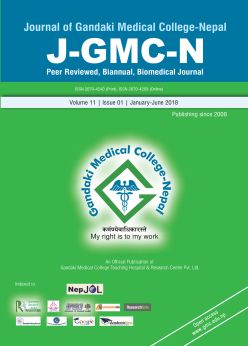Comparative study of Pelvi-calyceal system and relationship of structures at hilum of kidney between Nepalese and North Americans
DOI:
https://doi.org/10.3126/jgmcn.v12i2.27151Keywords:
structures and hilum of Kidney, pelvicalycealAbstract
Introduction: Pelvi-calyceal system consists of renal pelvis along with major and minor calyces.The minor calyces unite with their neighbors two or three chambers to form the major calyces. The major calyces drain into the infundibula. The renal pelvis is formed from the junction of the infundibula. The common pattern of arrangement of structures at the renal hilum, antero-poteriorly is renal vein, renal artery and pelvis.
Objectives: To compare the study of pelvi-calyceal system and relationship of structures at hilum of kidney between Nepalese and North Americans.
Methodology: The gross and prosected kidney specimens were studied for pelvi-calyceal system and relationship of structures at hilum of kidney in Anatomy department. In Nepal, the study was undertaken in Gandaki Medical College, Kaski and in USA, it was done in Well-cornel University, New York.
Result: Tricalyceal major calyx were found in 63.8% in Nepalese and Bicalyceal were found in 65.6% North Americans which is statistically significant variations. The number of minor calyces and pyramids varying 6 in Nepalese and 9 in North Americans were also statistically significant (p<0.05). The arrangement of structures at hilum of kidney from anterior to posterior(renal vein, artery and pelvis) in Nepalese and North American kidneys was 86.1% and 62.5% respectively whereas the structures arranged as renal artery, vein and pelvis from anterior to posterior was 13.9% and 37.5% .
Conclusion: There are significant variations in pelvicalyceal system and relations of structures at hilum of kidneys of Nepalese and North-Americans.
Downloads
References
Mishra P, Onkar D, Ksheersagar DD, Mishra D. The study of pelvi-caliceal system in adult human kidney. J Cont Med A Dent. 2015;3(2):12.
Jeremiah C Healy in Henry Gray’s Anatomy. The anatomical basis of clinical practice; 14th ed. Churchill Livingstone (Elsevier) publishers, pp 1230-1231.
Ryan S, Nicholas M, Eustace S. Anatomy for Diagnostic Imaging. 3rd ed. London: BailliereTindall, Elsevier Limited; 2011. pp. 196– 200.
Muthian E, Thiagarajan S, Shanmugam S. Gross morphological study of the renal pelvicalyceal patterns in human cadaveric kidneys. Indian J Urol. 2017;33(1):36-40.
Standring S. Gray’s Anatomy. The Anatomical Basis of Clinical Practice. 40th ed. New York: Churchill Livingstone Elsevier Limited; 2008. p. 1231.
Dunnick NR, Sandler CM, Newhouse JH, Amis ES. Textbook of Uroradiology. 4th ed. Philadelphia: Lippincott Williams & Wilkins; 2008.
Ningthoujam DD, Chongtham RD, Sinam SS. Pelvi-calyceal pattern in foetal and adult human kidneys. J AnatSoc India. 2005;54:1–11.
Singh K, Parmar P, Rohilla A, Katoch N, Kaur K, Rohilla J, et al. Renal hilum study for anomalous vasculature. Anat physiol. 2016;6:4.
Mishra GP, Bhatnagar S, Singh B. Unilateral Triple Renal Veins And Bilateral Double Renal Arteries- An Unique Case Report. Int J AnatRes. 2014;2:239- 41.
Vasi P. Variations on renal vessels- a cadaveric study. IOSR-JDMS. 2015;14(6):29.
Standring S, ed. Gray’s Anatomy. The Anatomical Basis of Clinical Practice. 40th Ed., Edinburg, Churchill & Livingstone. 2008;1231.
Moore KL, Persaud TVN. The Developing Human. Clinically Oriented Embryology. 8th Ed., New Delhi, Elsevier. 2008;249–50.
Standring S, Jeremiah HC, Glass J, Collins P, Wigley C, eds. Gray’s Anatomy. The Anatomical Basis of Clinical Practice. 39th Ed., London, New York, Oxford, Philadelphia, St. Louis, Sydney, Toronto, Elsevier Churchill Livingstone. 2005;1276–7.
Krishnaveni C, Kulkarni R, Sanikop MB, Venkateshu KV. A study of renal calyces by using barium contrast. Int J Anat Res.2014; 2(2):369- 74.
Trivedi S, Athavale S, Kotgiriwar S. Normal and variant anatomy of renal hilar structures and its clinical significance. Int J Morphol. 2011;29(4):1379- 83.
Wadekar PR, Gangane SD. Study of variations in the pelvicalyceal system of kidney and its clinical importance. Journal of college of Medical Sciences- Nepal. 2012;8(3):17-21.
Supriya K, Chaudhary J. Macroscopic- Morphometrical study of kidney and its clinical significance. International Journal of current research. 2014;6 (02):5073-78.
Ningthoujam DD, Chongtham RD, Sinam SS. Pelvi-caliceal system in foetal and adult human kidneys. J.Anat.Soc.India. 2005;54(1):1-11.
Sinha RR, Kumar B, Ashish K, Akhtar MJ, Kumar A, Kumar S, et al. Abnormal Anatomical Position and Number of Renal Artery at the Renal Hilum. J Indian Acad Forensic Med.2015;37(2):187-89.
Downloads
Published
How to Cite
Issue
Section
License
This license allows reusers to distribute, remix, adapt, and build upon the material in any medium or format for noncommercial purposes only, and only so long as attribution is given to the creator.

